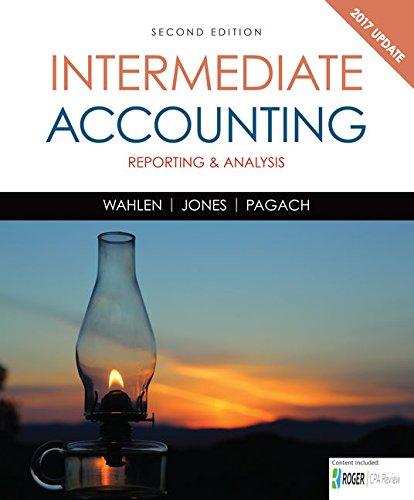
1 (a)
Prepare the
1 (a)
Explanation of Solution
Periodic inventory system: The method or system of recording the transactions related to inventory occasionally or periodically is referred as periodic inventory system.
Gross price method: Under gross price method, sales and purchases of inventory are recorded at the full invoice price (gross amount) without the deduction of discounts.
Journalize the transactions of Company EC:
| Date | Account title and Explanation | Post ref. | Amount | |
| Debit | Credit | |||
| April 11 | Purchases | $30,000 | ||
| Accounts payable | $30,000 | |||
| (To record the purchase of inventory of $30,000 on account, credit terms of 2/10,n/30 ) | ||||
| April 21 | Accounts payable | $30,000 | ||
| Purchases discounts (1) | $600 | |||
| Cash (2) | $29,400 | |||
| (To record the payment for inventory within the discount period) | ||||
Table (1)
April 11: To record the purchase of inventory of $30,000 on account, credit terms of2/10,n/30:
Purchases account is an expense and it is decreased the equity value by $30,000. Therefore, debit purchase account with $30,000.
Accounts payable is a liability and it is increased by $30,000. Therefore, credit accounts payable account with $30,000.
April 21: To record the payment for inventory within the discount period:
Accounts Payable is a liability and it is decreased because the company has paid the amount for the credit purchases. Therefore, debit Accounts Payable account with $30,000.
Purchases discount is a contra expense account to Purchase account and will have a normal credit balance. Therefore, Purchase discount account is credited with $600.
Cash is an asset and it is decreased because cash is paid for credit purchases. Therefore, credit Cash account with $29,400.
Working Note 1: Compute the discount on purchases.
Credit terms: The credit terms are 2/15,n/60. Company N makes payment for the inventory purchased within the discount period. Hence, the Company N is entitled to discount of 2%.
Discount on purchases=Purchases×Discount rate=$30,000×2100=$30,000×2100=$600
Working Note 2: Compute the cash paid to accounts payable (suppliers).
Cash paid to accounts payable=Purchases−Discount onpurchases=$30,000−$600(1)=$29,400
1 (b)
Prepare the journal entries to record the purchase and payment using net price method.
1 (b)
Explanation of Solution
Net price method: Under net price method, sales and purchases of inventory are recorded at the net invoice price which means the discounts are deducted from the gross invoice price.
Journalize the transactions of Company EC:
| Date | Account title and Explanation | Post ref. | Amount | |
| Debit | Credit | |||
| April 11 | Purchases (3) | $29,400 | ||
| Accounts payable | $29,400 | |||
| (To record the purchase of inventory of $30,000 on account, credit terms of 2/10,n/30 ) | ||||
| April 21 | Accounts payable | $29,400 | ||
| Cash | $29,400 | |||
| (To record the payment for Inventory within the discount period) | ||||
Table (2)
April 11: To record the purchase of inventory of $30,000 on account, credit terms of2/10,n/30:
Purchases account is an expense and it is decreased the equity value by $29,400. Therefore, debit purchase account with $29,400.
Accounts payable is a liability and it is increased by $29,400. Therefore, credit accounts payable account with $29,400.
April 21: To record the payment for inventory within the discount period:
Accounts Payable is a liability and is decreased because the company has paid the amount for the credit purchases. Therefore, debit Accounts Payable account with $29,400.
Cash is an asset and it is reduced because amount is paid for credit purchases. Therefore, credit Cash account with $29,400.
Working Note 3: Compute the net price of purchases.
Credit terms: The terms are 2/15,n/60. Company EC makes payment for the Inventory purchased within the discount period. Hence, the merchandising company is entitled to discount of 2%.
Net invoice price=Gross Invoice price−(Invoice price×Discount rate)=$30,000−($30,000×2100)=$30,000−$600=$29,400
2.
Compute the income that would be recognized by Company EC if it sells half of the inventory for $20,000 during April.
2.
Explanation of Solution
Income: This is the amount earned from operations of a business. The operating activities are sale of goods and services, and rent revenue.
Compute income.
| Computation of income | ||
| Particulars | Under gross price method | Under net price method |
| Sales | $20,000 | $20,000 |
| Less: Cost of goods sold ($30,000−$600)×50% | ($14,700) | ($14,700) |
| Income | $5,300 | $5,300 |
Table (3)
Thus, the income of $5,300 would be recognized by Company EC during the month of April.
3.
Journalize the purchase and payment transaction under each method if the Company makes payment on April 30.
3.
Explanation of Solution
Gross price method: Under gross price method, sales and purchases of inventory are recorded at the full invoice price (gross amount) without the deduction of discounts.
Journalize the transactions of Company N:
| Date | Account title and Explanation | Post ref. | Amount | |
| Debit | Credit | |||
| April 11 | Purchase | $30,000 | ||
| Accounts payable | $30,000 | |||
| (To record the purchase of inventory of $30,000 on account, credit terms of 2/10,n/30 ) | ||||
| April 30 | Accounts payable | $30,000 | ||
| Cash | $30,000 | |||
| (To record the payment for inventory after the discount period) | ||||
Table (4)
April 11: To record the purchase of inventory of $30,000 on account, credit terms of2/10,n/30:
Purchases account is an expense and it is decreased the equity value by $30,000. Therefore, debit purchase account with $30,000.
Accounts payable is a liability and it is increased by $30,000. Therefore, credit accounts payable account with $30,000.
April 30: To record the payment for inventory after the discount period:
Accounts Payable is a liability and is decreased because the company has paid the amount for the credit purchases. Therefore, debit Accounts Payable account with $30,000.
Cash is an asset and it is reduced because cash is paid for credit purchases. Therefore, credit Cash account with $30,000.
Net price method: Under net price method, sales and purchases of inventory are recorded at the net invoice price which means the discounts are deducted from the gross invoice price.
Journalize the transactions of Company N:
| Date | Account title and Explanation | Post ref. | Amount | |
| Debit | Credit | |||
| April 11 | Inventory (3) | $29,400 | ||
| Accounts payable | $29,400 | |||
| (To record the purchase of inventory of $30,000 on account, credit terms of2/10,n/30) | ||||
| April 30 | Accounts payable | $29,400 | ||
| Purchase discount lost | $600 | |||
| Cash | $30,000 | |||
| (To record the payment for Inventory after the discount period) | ||||
Table (5)
April 11: To record the purchase of inventory of $30,000 on account, credit terms of2/10,n/30:
Purchases account is an expense and it is decreased the equity value by $29,400. Therefore, debit purchase account with $29,400.
Accounts payable is a liability and it is increased by $29,400. Therefore, credit accounts payable account with $29,400.
April 30: To record the payment for Inventory after the discount period:
Accounts Payable is a liability and is decreased because the cash has paid the amount for the credit purchases. Therefore, debit Accounts Payable account with $29,400.
Purchases discount lost is a component of
Cash is an asset and it is reduced because amount is paid for credit purchases. Therefore, credit Cash account with $30,000.
4.
Compute the net income that would be recognized by Company EC if it sells half of the inventory for $20,000 during April.
4.
Explanation of Solution
Compute income.
| Computation of income | ||
| Particulars |
Under gross price method (Value of inventory is $30,000) |
Under net price method (Value of inventory is $29,400) |
| Sales | $20,000 | $20,000 |
| Less: Cost of goods sold (Value of inventory)×50% | ($15,000) | ($14,700) |
| Less: Purchase discounts | ($600) | |
| Income | $5,000 | $4,700 |
Table (6)
Thus, under gross price method income of $5,000 and in net price method, income of $4,700 would be recognized by Company EC during the month of April.
5.
Explain the differences in income computed in requirement 4 under two methods.
5.
Explanation of Solution
The major reason for the difference is due to the treatment of discount under two methods. In net price method, the discount loss is treated as an expense and in gross method the discount is included in inventory and is not expensed till the inventories are sold.
Want to see more full solutions like this?
Chapter 7 Solutions
Cengagenowv2, 1 Term Printed Access Card For Wahlen/jones/pagach’s Intermediate Accounting: Reporting And Analysis, 2017 Update, 2nd
- Selby Digital Solutions has: Sales: $25.5 million Total Assets: $16.2 million (not needed for this calculation) Total Debt: $6.8 million (not needed for this calculation) Profit Margin: 9.5% What is the net income?arrow_forwardHi expertarrow_forwardGalaxy Electronics sold 4,500 units in 2020 at $600 each. Variable costs: $450 per unit Fixed costs: $250,000 What was Galaxy Electronics' 2020 net income? A. $275,000 B. $325,000 C. $400,000 D. $425,000arrow_forward
- Nicole Manufacturing had 780 units in beginning work in process on September 1, 2023. During the month, an additional 2,600 units were started in production. At the end of September, 1,150 units remained in work in process. How many units were completed during September?arrow_forwardGeneral accounting questionarrow_forwardJames Wilson is the sole shareholder of Wilson Enterprises. As of December 31, 2022, Wilson Enterprises reported assets of $785,300 and liabilities of $324,150. During 2023, James invested an additional $45,000 in the company by purchasing new shares and received dividends of $32,500. What was the net income of Wilson Enterprises for 2023 if the company reported assets of $897,600 and liabilities of $295,800 as of December 31, 2023? a. $103,150 b. $72,350 c. $140,650 d. $35,000arrow_forward
- I need assistance with this general accounting question using appropriate principles.arrow_forwardHello tutor please given Financial accounting question answer do fast and properly explain all answerarrow_forwardCan you solve this financial accounting problem with appropriate steps and explanations?arrow_forward
 Intermediate Accounting: Reporting And AnalysisAccountingISBN:9781337788281Author:James M. Wahlen, Jefferson P. Jones, Donald PagachPublisher:Cengage Learning
Intermediate Accounting: Reporting And AnalysisAccountingISBN:9781337788281Author:James M. Wahlen, Jefferson P. Jones, Donald PagachPublisher:Cengage Learning Survey of Accounting (Accounting I)AccountingISBN:9781305961883Author:Carl WarrenPublisher:Cengage Learning
Survey of Accounting (Accounting I)AccountingISBN:9781305961883Author:Carl WarrenPublisher:Cengage Learning Financial Accounting: The Impact on Decision Make...AccountingISBN:9781305654174Author:Gary A. Porter, Curtis L. NortonPublisher:Cengage Learning
Financial Accounting: The Impact on Decision Make...AccountingISBN:9781305654174Author:Gary A. Porter, Curtis L. NortonPublisher:Cengage Learning Financial AccountingAccountingISBN:9781305088436Author:Carl Warren, Jim Reeve, Jonathan DuchacPublisher:Cengage Learning
Financial AccountingAccountingISBN:9781305088436Author:Carl Warren, Jim Reeve, Jonathan DuchacPublisher:Cengage Learning College Accounting, Chapters 1-27 (New in Account...AccountingISBN:9781305666160Author:James A. Heintz, Robert W. ParryPublisher:Cengage Learning
College Accounting, Chapters 1-27 (New in Account...AccountingISBN:9781305666160Author:James A. Heintz, Robert W. ParryPublisher:Cengage Learning Financial AccountingAccountingISBN:9781337272124Author:Carl Warren, James M. Reeve, Jonathan DuchacPublisher:Cengage Learning
Financial AccountingAccountingISBN:9781337272124Author:Carl Warren, James M. Reeve, Jonathan DuchacPublisher:Cengage Learning





